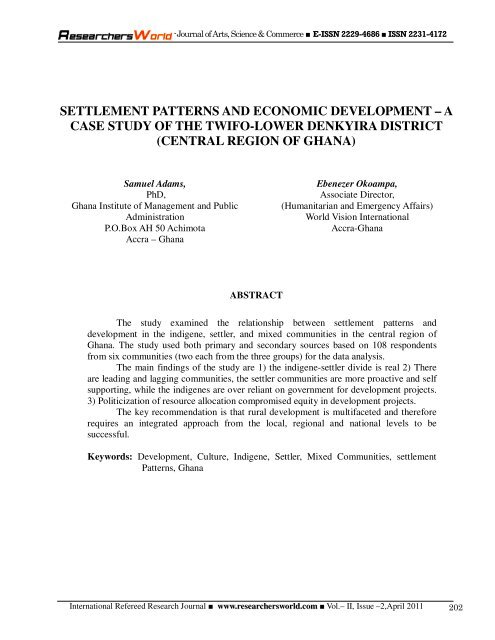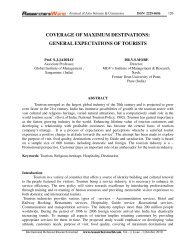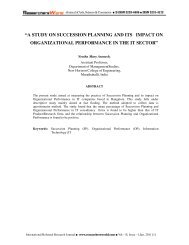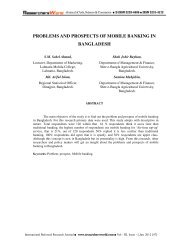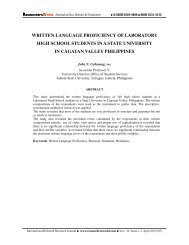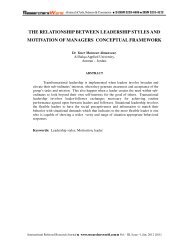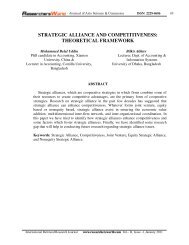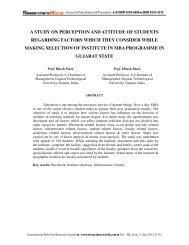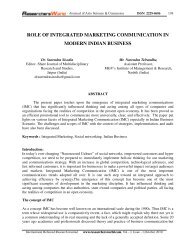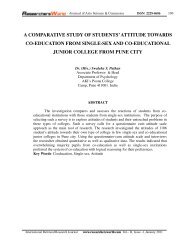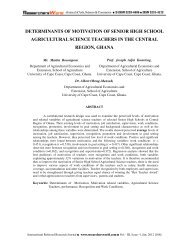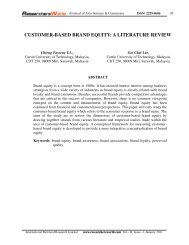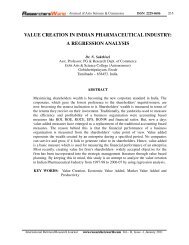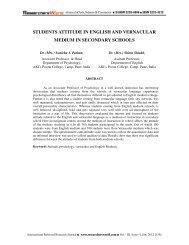settlement patterns and economic development - Researchers World
settlement patterns and economic development - Researchers World
settlement patterns and economic development - Researchers World
You also want an ePaper? Increase the reach of your titles
YUMPU automatically turns print PDFs into web optimized ePapers that Google loves.
-Journal of Arts, Science & Commerce ■ E-ISSN 2229-4686 ■ ISSN 2231-4172<br />
SETTLEMENT PATTERNS AND ECONOMIC DEVELOPMENT – A<br />
CASE STUDY OF THE TWIFO-LOWER DENKYIRA DISTRICT<br />
(CENTRAL REGION OF GHANA)<br />
Samuel Adams,<br />
PhD,<br />
Ghana Institute of Management <strong>and</strong> Public<br />
Administration<br />
P.O.Box AH 50 Achimota<br />
Accra – Ghana<br />
Ebenezer Okoampa,<br />
Associate Director,<br />
(Humanitarian <strong>and</strong> Emergency Affairs)<br />
<strong>World</strong> Vision International<br />
Accra-Ghana<br />
ABSTRACT<br />
The study examined the relationship between <strong>settlement</strong> <strong>patterns</strong> <strong>and</strong><br />
<strong>development</strong> in the indigene, settler, <strong>and</strong> mixed communities in the central region of<br />
Ghana. The study used both primary <strong>and</strong> secondary sources based on 108 respondents<br />
from six communities (two each from the three groups) for the data analysis.<br />
The main findings of the study are 1) the indigene-settler divide is real 2) There<br />
are leading <strong>and</strong> lagging communities, the settler communities are more proactive <strong>and</strong> self<br />
supporting, while the indigenes are over reliant on government for <strong>development</strong> projects.<br />
3) Politicization of resource allocation compromised equity in <strong>development</strong> projects.<br />
The key recommendation is that rural <strong>development</strong> is multifaceted <strong>and</strong> therefore<br />
requires an integrated approach from the local, regional <strong>and</strong> national levels to be<br />
successful.<br />
Keywords: Development, Culture, Indigene, Settler, Mixed Communities, <strong>settlement</strong><br />
Patterns, Ghana<br />
International Refereed Research Journal ■ www.researchersworld.com ■ Vol.– II, Issue –2,April 2011 202
-Journal of Arts, Science & Commerce ■ E-ISSN 2229-4686 ■ ISSN 2231-4172<br />
INTRODUCTION:<br />
The discussion of <strong>settlement</strong> <strong>patterns</strong> examines the historical flows <strong>and</strong> migration <strong>patterns</strong> of<br />
the population over time. By observing past <strong>and</strong> present <strong>settlement</strong> <strong>patterns</strong> we can observe the<br />
impact of change on different communities. Konseiga (2005) has noted that West Africa is an area<br />
with a long tradition of human mobility, which was enhanced particularly during the colonial period.<br />
However, after independence, this population mobility turned into labour migration for wage work,<br />
weaving a complex grid of relations <strong>and</strong> inter-dependence over the artificial borders inherited from<br />
colonialism. Migration remained very attractive because migrants were not disconnected from their<br />
home country.<br />
Ghana has a long history <strong>and</strong> a tradition of planning national <strong>development</strong>. According to the<br />
2001 Organization for Economic Cooperation <strong>and</strong> Development (OECD) publication, preindependence<br />
Gold Coast completed the first <strong>development</strong> plan in the world – known then as the<br />
Guggisberg Plan in 1919. The plan sought to develop the Gold Coast up to 1926. However, 53 years<br />
after independence in 1957, the <strong>development</strong> <strong>patterns</strong> that have emerged manifest major inequalities<br />
among rural communities. The disparities are clearly seen in the rural districts of Ghana of which<br />
Twifo-Hemang-Lower Denkyira (THLD) District (focus of this study) is a living example was<br />
established by Legislative Instrument (L.I) 1377 in 1988.<br />
The study focuses on six communities in the Twifo-Hemang-Lower Denkyira District in the<br />
Central Region of Ghana to examine the <strong>development</strong> <strong>patterns</strong> by comparing situations among three<br />
distinct groups of <strong>settlement</strong>s namely the indigenes, mixed <strong>and</strong> settler communities. This is important<br />
because the definition of settler <strong>and</strong> indigene often determines who gets what, <strong>and</strong> when <strong>and</strong> how<br />
they get it in such communities (Orock, 2005: Danfulani, 2006). Further, we explore how l<strong>and</strong> tenure<br />
<strong>and</strong> possibly politics influence differing personal <strong>and</strong> community <strong>development</strong> <strong>patterns</strong> <strong>and</strong> to find<br />
out the reasons for the low level of <strong>development</strong> in the district. These are discussed on the basis of the<br />
physical growth levels, the people’s cultural values <strong>and</strong> motivations in undertaking community selfhelp<br />
activities, occupational issues <strong>and</strong> collaboration with external <strong>development</strong> actors among others.<br />
This study is thus a contribution to the importance of migration <strong>and</strong> its socio<strong>economic</strong> <strong>and</strong> political<br />
implications, particularly in the context of Sub-Sahara Africa (SSA).<br />
The study is an exploratory study that focuses on the perceptions of the residents of the<br />
communities under study <strong>and</strong> seeks to contribute to the literature in terms of how <strong>settlement</strong> <strong>patterns</strong><br />
affect <strong>development</strong>. The rest of the paper is organised as follows. Section two presents the literature<br />
review, <strong>and</strong> is followed by the data <strong>and</strong> methodology in section three. Section four analyses the data<br />
<strong>and</strong> the conclusions <strong>and</strong> policy implications are presented in the final section.<br />
.<br />
LITERATURE REVIEW:<br />
The literature review begins with the definition of key concepts, after which we present<br />
background of the study area. Finally, we discuss the theoretical <strong>and</strong> empirical literature on the<br />
relationship between <strong>settlement</strong> <strong>patterns</strong> <strong>and</strong> <strong>economic</strong> <strong>development</strong>.<br />
DEFINITIONS:<br />
A few concepts which need to be defined here include <strong>development</strong>, indigenes, settler, <strong>and</strong><br />
mixed communities. Development means different things to different people. Lewis (1984) defined<br />
<strong>economic</strong> <strong>development</strong> as the study of <strong>economic</strong> structure <strong>and</strong> behaviour of the poor, while<br />
Kindleberger (1965), Hirschman (1958), Amartya (1988), <strong>and</strong> Stiglitz (1998) described <strong>economic</strong><br />
<strong>development</strong> as the transformation of society in terms of improvements in health <strong>and</strong> education, <strong>and</strong><br />
International Refereed Research Journal ■ www.researchersworld.com ■ Vol.– II, Issue –2,April 2011 203
-Journal of Arts, Science & Commerce ■ E-ISSN 2229-4686 ■ ISSN 2231-4172<br />
an increase in productive capacity as well as an increase in per capita income. Thus, <strong>economic</strong><br />
<strong>development</strong> implies changes in both the structure of inputs <strong>and</strong> in the allocation of those inputs. Atal<br />
(1997) <strong>and</strong> Myers (1999) claim that <strong>economic</strong> growth does not necessarily lead to social <strong>development</strong><br />
<strong>and</strong> therefore a holistic approach to change in life structure in the realm of the material, social, <strong>and</strong><br />
the spiritual is vital in promoting <strong>economic</strong> <strong>development</strong>. Madu (2003) characterizes the essence of<br />
rural <strong>development</strong> as the improvement of the spatial <strong>and</strong> socio<strong>economic</strong> environment of the rural<br />
space, which leads to the enhancement of the individual’s ability to care for <strong>and</strong> sustain his or her<br />
well-being. In other words, <strong>development</strong> must improve all aspects of peoples’ lives, what Servaes<br />
(1999) <strong>and</strong> Madu (2003) refer to as multi-dimensional <strong>development</strong>.<br />
The term indigene has no universal definition. Shah (2007) refers to peculiar characteristics of<br />
indigenes as those with historical continuity, self-identification, distinct social, political systems <strong>and</strong><br />
language. Indigenes are those who belong to the group of people who were the original inhabitants<br />
or the first to settle in a particular place <strong>and</strong> who therefore claim to be its rightful owners. The<br />
indigenes enjoy privileges when it comes to <strong>development</strong>; they are located along the main trunk road,<br />
they own the l<strong>and</strong> <strong>and</strong> are the reference points for any l<strong>and</strong> use by outsiders <strong>and</strong> external <strong>development</strong><br />
agencies that might require l<strong>and</strong> to initiate <strong>development</strong> projects. Even more important is the fact<br />
they are more likely to receive government support for <strong>development</strong> projects (Orock, 2005).<br />
Settlers refer to internal migrants who have travelled from one part of the country to another<br />
location <strong>and</strong> have settled temporarily or permanently. They are described simply as non-indigenes<br />
(Human Rights watch, 2006). Konseiga (2005) has recorded the long tradition of human mobility<br />
within SSA <strong>and</strong> makes specific reference to Ghana, Cote d’Ivoire, Senegal <strong>and</strong> Nigeria. Konseiga<br />
concluded that the main attractions to the new found l<strong>and</strong>s were the cocoa in Ghana <strong>and</strong> Cote d’Ivoire,<br />
coffee in Cote d’Ivoire which attracted workforce from Mali, Niger <strong>and</strong> Burkina Faso, the French<br />
automobile industry in Senegal <strong>and</strong> the temporary Nigerian <strong>economic</strong> strength at the time. In the<br />
1980s, however, the pattern could not be sustained due to the host countries’ severe <strong>economic</strong> crisis<br />
that compelled the host countries to implement restrictive migration policies. The <strong>economic</strong> reasons<br />
to which Konseiga (2005) made reference appear not to be the only factor. Issues of security from<br />
violent conflicts <strong>and</strong> chronic drought <strong>and</strong> disease among others weigh very high on the scale. The<br />
greatest challenge a settler community faces is the acquisition of l<strong>and</strong> (l<strong>and</strong> tenure system). Most l<strong>and</strong><br />
in the district (study area) like most parts of the country are stool l<strong>and</strong>s or family owned with a few<br />
being privately owned.<br />
Mixed communities are places with a range of households <strong>and</strong> a blending of people by their<br />
social characteristics <strong>and</strong> behaviour (Tunstall <strong>and</strong> Fenton, 2006). Deriving clues from the descriptions<br />
of indigene <strong>and</strong> settler communities in this document, mixed communities are basically a fusion of<br />
people with earliest historical <strong>settlement</strong> <strong>and</strong> the new entrants to the area. It may be that both parties<br />
(indigenes <strong>and</strong> non-indigenes who are usually in the minority) may have started a new <strong>settlement</strong><br />
together in a location dominated by one ethnic group.<br />
The three groups of <strong>settlement</strong>s may exhibit specific cultural types or behaviours that have an<br />
effect on their <strong>development</strong> <strong>patterns</strong>. Culture in this sense refers to informal shared values, norms,<br />
meanings <strong>and</strong> behaviours that characterize human societies (Fukuyama, 2001). Underst<strong>and</strong>ing the<br />
cultural <strong>and</strong> sub cultural-types of the different communities helps to advance our underst<strong>and</strong>ing of<br />
not only the differences among people’s social relationships, but also the universal nature of human<br />
beings, their social relationships with others <strong>and</strong> their overall <strong>development</strong> (Takahashi, 2001). In the<br />
developing world, a shift in thinking has occurred whereby culture is now widely seen as being more<br />
central to the <strong>development</strong> process, especially where a human-centred rather than a goods-centred<br />
view of <strong>development</strong> is taken (Streeten, 1997; Tabellini, 2005).<br />
International Refereed Research Journal ■ www.researchersworld.com ■ Vol.– II, Issue –2,April 2011 204
THEORETICAL AND EMPIRICAL OVERVIEW:<br />
-Journal of Arts, Science & Commerce ■ E-ISSN 2229-4686 ■ ISSN 2231-4172<br />
Speaking to the theoretical underpinnings of culture <strong>and</strong> <strong>development</strong>, Welzel, Inglehart, <strong>and</strong><br />
Klingemann (1999) posited that cultural change is one of the key elements constituting social<br />
progress as it links an individual to his community’s resources use, values <strong>and</strong> freedom rights.<br />
Development theory, however, is consistent wit the perception that culture is not deterministic, thus,<br />
the relationship between the two variables is dynamic (Tabellini, 2005). It may be concluded<br />
therefore that even though culture matters, it is not an independent variable as it is influenced by<br />
other factors like the environment, education, <strong>and</strong> experience gained from disasters among others.<br />
Granholm <strong>and</strong> Anderson (2005) observed that culture is indeed an important <strong>economic</strong> resource <strong>and</strong><br />
that the experiences <strong>and</strong> products that grow out of our cultural heritage are an essential component of<br />
the health of an economy. With respect to the l<strong>and</strong> question, Galor, Moaw, <strong>and</strong> Vollrath (2008) noted<br />
that inequality in the distribution of l<strong>and</strong> ownership adversely affected the emergence of human<br />
capital promoting institutions <strong>and</strong> consequently the pace <strong>and</strong> the nature of the transition from an<br />
agricultural to an industrial economy.<br />
Similarly, Orock (2005) sees the indigene-settler divide in the urban space as an emanation of<br />
the l<strong>and</strong> question, <strong>and</strong> hinges on the role modernization has played in the process. Further, Orock<br />
noted that the divide is worsened by the fact the government <strong>and</strong> other community groups have<br />
resorted to a politicization of the l<strong>and</strong> question. Berube (2005), for example, describes non-indigenes<br />
as ‘trapped in worst locations.’ In some cases, the new arrivals to a community are subtly made to<br />
settle at the periphery of the town. With time when they underst<strong>and</strong> the reasons behind the decision of<br />
their host, the feeling of belongingness is eroded <strong>and</strong> replaced by a sense of solidarity among fellow<br />
migrants because of their ‘non-citizenship’ status. They feel compelled to invest their resources in<br />
their hometowns rather than to help develop their new location. The argument here is that <strong>economic</strong>s<br />
cannot be discussed without an underst<strong>and</strong>ing of the cultural, communal, <strong>and</strong> societal identities of a<br />
particular people (Lloyd <strong>and</strong> Metzer, 2006) This supports the statement by Danfulani (2006) that the<br />
division between indigenes <strong>and</strong> non-indigenes could be attributed to factors that are primarily<br />
<strong>economic</strong>, social, <strong>and</strong> political that bother on the issue of access to l<strong>and</strong>, power, <strong>and</strong> resources.<br />
Winters et al. (2008) claimed that the factors which drive the <strong>development</strong> process <strong>and</strong> cause<br />
growth experience differ significantly. For example, Galor et al. (2008) in their empirical study of<br />
l<strong>and</strong> ownership <strong>and</strong> <strong>development</strong> in Japan, Korea, Russia, Taiwan, North <strong>and</strong> Latin America<br />
identified a relationship between l<strong>and</strong> ownership, education reforms <strong>and</strong> the process of <strong>development</strong>.<br />
It was noted from the study that in societies with scarce l<strong>and</strong> or its ownership distributed equally, the<br />
process of <strong>development</strong> allows the implementation of an optimal education policy <strong>and</strong> rapid process<br />
of <strong>development</strong>. Also, Akinboye et al.’s (2007) study of indigenes (Yorubas) in Ogun State of Nigeria<br />
showed that inappropriate community recognition of the role played by the youth, parental influence,<br />
<strong>and</strong> insufficient assistance from the government at the grassroots level were critical elements that<br />
undermined <strong>development</strong> in most communities in the Ogun State.<br />
In a related study by Brennan <strong>and</strong> Cooper (2005) on the cultural divide of rural Appalachian<br />
Mountain natives <strong>and</strong> immigrants in United States of America, the findings suggest a marked<br />
difference in the attitudes <strong>and</strong> values of the two groups of inhabitants. The main finding of the study<br />
was that the irreconcilable differences between the two groups slowed down the <strong>development</strong> of the<br />
area. Aleksynska (2007) confirmed this in her study on civic participation of immigrants <strong>and</strong> culture<br />
transmission <strong>and</strong> assimilation. The key finding in the study was that the host culture matters most in<br />
generating corresponding higher or lower participation of immigrants in the <strong>development</strong> activities of<br />
the area. On the other h<strong>and</strong>, Richards (2006) argued that cultural distance between the new<br />
destination <strong>and</strong> home country made young people more tolerant of other cultures, increase their trust<br />
of other people <strong>and</strong> gain wider knowledge to enhance their personal <strong>development</strong>.<br />
International Refereed Research Journal ■ www.researchersworld.com ■ Vol.– II, Issue –2,April 2011 205
-Journal of Arts, Science & Commerce ■ E-ISSN 2229-4686 ■ ISSN 2231-4172<br />
Additionally, Clevoulou (1998) in a study of Talensi in the Upper East Region of Ghana<br />
reported a dynamic relationship between culture <strong>and</strong> <strong>development</strong>. Clevoulou (1998) noted, for<br />
example, that the traditional practice of helping one another in the business of thatching roofs helped<br />
in building communal spirit. This contrasts the findings Burchill <strong>and</strong> Higgins (2005) that<br />
implementation of the <strong>development</strong> projects contributed to the loss of culture among the Aborigines<br />
of Australia. Adhikari <strong>and</strong> Falco (2008) examined the issue of social inequality <strong>and</strong> collective action<br />
regarding the culture of decision making in eight forest communities in Nepal <strong>and</strong> India indicated that<br />
one’ s status in society was a key element for inclusion or exclusion in village decision making<br />
processes of the local commons. Huq (2007) also notes that inequality in l<strong>and</strong> distribution leads to<br />
increasing social polarization <strong>and</strong> plays a discriminating role in deriving benefits accrued from<br />
<strong>development</strong> efforts in agriculture.<br />
In summary, the literature reviewed here indicates that there is a relationship between the<br />
<strong>settlement</strong> <strong>patterns</strong> <strong>and</strong> <strong>economic</strong> <strong>development</strong>. This study contributes to the literature on <strong>settlement</strong><br />
<strong>patterns</strong> <strong>and</strong> <strong>development</strong> in the context of six communities in the Central Region of Ghana. The<br />
data for the analysis is discussed next.<br />
DATA AND METHODOLOGY (INDICATE HOW MANY KEY FORMANTS FOR EACH<br />
GROUP):<br />
A mixed methods approach was adopted for this study to analyse the <strong>development</strong> <strong>patterns</strong> in<br />
indigene, mixed <strong>and</strong> settler communities. The use of open ended questionnaire provided greater<br />
freedom to respondents to speak their minds <strong>and</strong> to ask questions. The questions took approximately<br />
45 minutes to complete. The text of all survey materials stressed that participation was voluntary <strong>and</strong><br />
that individual results would be kept confidential. Survey materials also stressed the investigator’s’<br />
desire to underst<strong>and</strong> challenges to <strong>development</strong> as it relates to their culture <strong>and</strong> <strong>settlement</strong> <strong>patterns</strong>.<br />
Secondary data was obtained from the District Assembly <strong>and</strong> the Area Development Programme<br />
(ADP) office of <strong>World</strong> Vision Ghana (WVG).<br />
The sample frame was obtained from six communities which form the target population.<br />
Initially, 120 respondents were targeted to be part of the study. However, 108 responded to the<br />
questionnaires, which represent a response rate of 90%. The respondents are made up of 35 people<br />
from the indigene, 40 from the settler, <strong>and</strong> 33 from the mixed communities.<br />
Three visits were undertaken to each of the target communities. The first visit was basically<br />
exploratory to build rapport with the communities. The second visit was devoted to the actual<br />
interviews, while the third was for verification of the data <strong>and</strong> provided space for feedback from the<br />
respondents. The survey tools used in this study consisted of two categories of questionnaires, one for<br />
key informants <strong>and</strong> the other for households. It is common knowledge that the people about whom<br />
one is studying possess a great deal of information (what is commonly referred to as indigenous<br />
knowledge). It makes sense to explore their situation better with their input derived from personal<br />
interviews. On the other h<strong>and</strong>, it is evident that a community is made up of individuals who are from<br />
households, whose orientation is important in shaping the perspectives of the community.<br />
The survey questionnaire sought to gather information on the demographic <strong>and</strong> occupational<br />
issues, knowledge about <strong>development</strong> <strong>and</strong> causes of lack of <strong>development</strong>, influence of family <strong>and</strong><br />
community values, <strong>and</strong> the leadership factor in community <strong>development</strong> from both households <strong>and</strong><br />
key informants. In arriving at the major related questions, the 1997 Ghana Living St<strong>and</strong>ard Survey<br />
draft document was taken into consideration.<br />
International Refereed Research Journal ■ www.researchersworld.com ■ Vol.– II, Issue –2,April 2011 206
RESULTS AND DISCUSSION:<br />
-Journal of Arts, Science & Commerce ■ E-ISSN 2229-4686 ■ ISSN 2231-4172<br />
The data collected allowed us to discuss the results under four main headings:<br />
Demographic information on respondents<br />
Trend of <strong>development</strong><br />
Values of people<br />
Causes of lack of <strong>development</strong><br />
DEMOGRAPHIC INFORMATION OF THE RESPONDENTS:<br />
In this section, we provide information on the age <strong>and</strong> gender (Table 1) <strong>and</strong> occupational mix<br />
of the different communities (Table 2). The sample was made up of 77 men <strong>and</strong> 31 women. For the<br />
three different <strong>settlement</strong> groups, the modal age group is the 41-50 year group; 12 for the indigene<br />
group, 15 for the settler, <strong>and</strong> 12 for the mixed communities. Thus, of the 108 respondents 39 (27%)<br />
are in the 41-50 year category, while the 61-70 age group make up only 12% (14) of the population. It<br />
is important to note, however, that the number is highest in the indigene communities than in either<br />
the mixed or the settler communities. This could also be explained by the fact that many of the<br />
settlers go back to their original towns as they age.<br />
OCCUPATIONAL MIX:<br />
Of the 20 people in the indigene group who responded to the question on occupation, only<br />
seven (35%) indicated that they were full time farmers. The others were involved in other trades as<br />
seen in Table 2. Many of the respondents, however, indicated that though they were not farmers, they<br />
had farm l<strong>and</strong>s. This means they hired labourers to work on their farms. Of those who are farmers or<br />
are involved in farming, 18 respondents had full title to the Farm l<strong>and</strong>. This privilege enables them to<br />
generate adequate rent income to pay for the cost of children’s education, family upkeep, investing in<br />
family projects like rehabilitating the houses or building new ones, exp<strong>and</strong>ing farms, <strong>and</strong> contributing<br />
toward community<br />
Table 1: Gender <strong>and</strong> age of respondents<br />
Focus Group Age Male Female Total Respondents<br />
20 – 30 2 0 2<br />
Indigenous 31 – 40 6 2 8<br />
41 – 50 9 3 12<br />
51 – 60 3 2 5<br />
61 – 70 5 3 8<br />
Sub-Total 25 10 35<br />
20 – 30 4 1 5<br />
Settler<br />
31 – 40 7 3 10<br />
41 – 50 11 4 15<br />
51 – 60 4 3 7<br />
61 – 70 2 1 3<br />
Sub-Total 28 12 40<br />
20 – 30 2 1 3<br />
31 – 40 4 2 6<br />
International Refereed Research Journal ■ www.researchersworld.com ■ Vol.– II, Issue –2,April 2011 207
-Journal of Arts, Science & Commerce ■ E-ISSN 2229-4686 ■ ISSN 2231-4172<br />
Mixed 41 – 50 9 3 12<br />
51 – 60 6 3 9<br />
61 – 70 3 0 3<br />
Sub-Total 24 9 33<br />
Gr<strong>and</strong> Total 77 31 108<br />
Table 2: Occupational mix of Respondents.<br />
Occupation Frequency Percentage<br />
(%)<br />
Frequency Percentage<br />
(%)<br />
Frequency Percentage<br />
(%)<br />
Indigenes Settler communities Mixed<br />
communities<br />
Farmers 7 35 19 95% 14 70<br />
Traders 2 10 1 5% 3 15<br />
Artisan 3 15<br />
Labourer 2 10 2 10<br />
Teacher 3 15 1 5<br />
Draughtsman 1 5<br />
Driver 1 5<br />
Local Gin 1 5<br />
Brewer<br />
Total 20 100.0 20 100.0 20 100.0<br />
<strong>development</strong>. In the mixed communities, 14 (70%) of the respondents are farmers <strong>and</strong> the rest (30%)<br />
are indicated that they are farmers <strong>and</strong> only one respondent (5%) is a hairdresser but makes time to<br />
engage in petty trading.Most of the farmers are also involved in petty trading.<br />
Most of the people in the settler <strong>and</strong> mixed communities are tenant farmers who do not have<br />
title to the l<strong>and</strong> on which they farm. The lease is usually for 5-10 years <strong>and</strong> is renewable depending<br />
on the relationship between the tenant <strong>and</strong> his l<strong>and</strong>lord. There is universal agreement among the<br />
tenant farmers that the existing tenure system is not helpful to them as in most cases the profits or<br />
produce from the farm l<strong>and</strong> are always shared equally between the tenant <strong>and</strong> his l<strong>and</strong>lord. The<br />
dissatisfaction on the part of the tenants usually leads to disagreements <strong>and</strong> sometimes conflict. What<br />
worsens the conflict is when a l<strong>and</strong>lord decides unilaterally to change the terms of the agreement.<br />
This is especially so when the tenant farmer is perceived to be prospering.<br />
The respondents indicated that they endure the hardships because they had come from far <strong>and</strong><br />
deprived communities to their present <strong>settlement</strong> <strong>and</strong> consequently they have to be able to send<br />
something back to their original or home communities as culture dem<strong>and</strong>s. The key to survival<br />
according to the key informants is that they are very careful as to the way they spend their money.<br />
The focus is to maintain their families, support children’s education, exp<strong>and</strong> their farms <strong>and</strong> to be<br />
able to undertake personal projects in their respective hometowns.<br />
VALUES OF THE PEOPLE:<br />
The responses to their work ethic led to questions about their value systems. On the subject of<br />
values that drive the mission <strong>and</strong> vision of the respondents, almost all the groups indicated that<br />
children’s education <strong>and</strong> wellbeing is a top priority. Indeed, it is the most important element for the<br />
indigene communities, while self worth was the most important for the settler communities (Table 3).<br />
International Refereed Research Journal ■ www.researchersworld.com ■ Vol.– II, Issue –2,April 2011 208
Majority of the mixed communities reported that<br />
-Journal of Arts, Science & Commerce ■ E-ISSN 2229-4686 ■ ISSN 2231-4172<br />
Table 3: Household values in indigenous communities<br />
Response<br />
Selfworth<br />
Frequency Percentage<br />
(%)<br />
Frequency Percentage<br />
(%)<br />
5 25 8 47<br />
Frequency Percentage<br />
(%)<br />
Children’s<br />
education<br />
<strong>and</strong> wellbeing<br />
Family<br />
links <strong>and</strong><br />
values<br />
Peaceful<br />
coexistence<br />
Hard<br />
work to<br />
earn a<br />
living<br />
Good<br />
Health<br />
9 45 5 29.4 6 33.3<br />
9 50<br />
6 30 3 16.7<br />
2 11.8<br />
2 11.8<br />
Total<br />
20 100.0 17 100<br />
18 100.0<br />
family links in general was very important to them <strong>and</strong> thus they did all they could to maintain a<br />
relationship with the extended family in their hometowns. This could be attributed to the continual<br />
conflict between the two groups especially over l<strong>and</strong> issues, which made the issue of peaceful<br />
coexistence an important value for the indigene <strong>and</strong> mixed communities. Interestingly, the settler<br />
communities mentioned two other factors that really define their livelihood; hard work <strong>and</strong> good<br />
health. Obviously, hard work is critical but one needs a sound <strong>and</strong> a healthy body to be able to work<br />
hard. It is not surprising therefore that it is only in the settler <strong>and</strong> mixed communities (Asensoho <strong>and</strong><br />
Jukwa-Krobo towns respectively) that have community clinics (See Table 4 for <strong>development</strong> trends).<br />
The important thing to note here is that the <strong>settlement</strong> groups have different value systems, decision<br />
making styles which determine the community pace. The next issue to be discussed then is whether<br />
the culture in terms of their occupations, work ethic <strong>and</strong> value systems of the communities has an<br />
effect on the <strong>development</strong> trend. This is discussed next.<br />
Development trends<br />
Table 4 below summarises the differing <strong>development</strong> experience during the past 10 years. The<br />
indigene communities are more endowed than the settler <strong>and</strong> the mixed communities. For example,<br />
access to electricity <strong>and</strong> a community centre are available only in the indigene communities. Further,<br />
it is only the indigene community (Ntafrewaso) that is tarred <strong>and</strong> two km of road is to be tarred in the<br />
Nyinase (an indigene town). So far, there is no indication of when any of these amenities would be<br />
International Refereed Research Journal ■ www.researchersworld.com ■ Vol.– II, Issue –2,April 2011 209
available to the settler <strong>and</strong> mixed communities.<br />
Table 4: Development Trend (1998 – 2008)<br />
-Journal of Arts, Science & Commerce ■ E-ISSN 2229-4686 ■ ISSN 2231-4172<br />
Completed Projects Ntafrewaso Nyinase Kyeabiso Asensoho Jukwa- Mintaso<br />
Shed Krobo<br />
Nursery School 2003 2000 Not Not Not Not<br />
Block<br />
available available available available<br />
Boreholes 2005 2003 Not available 2006<br />
Primary School 2004 2005 1999 2004 2003 2008<br />
Block<br />
Junior High School 1998 1999 2008 2002 1998 (new 2005<br />
Block<br />
block by<br />
District<br />
Assembly<br />
( 2008)<br />
Teachers<br />
Accommodation<br />
2000 1999 Not available Not<br />
available<br />
Not<br />
available<br />
2005<br />
Cocoa Shed old<br />
structure<br />
(before<br />
1998)<br />
KVIP Toilets 2002 &<br />
2007 by<br />
TOPP<br />
Community Clinic Not<br />
available<br />
Initiators of DA <strong>and</strong><br />
Projects<br />
NGOs<br />
old<br />
structure<br />
(before<br />
1998)<br />
2004<br />
(Community<br />
initiated)<br />
2006 2008 (for<br />
school)<br />
Not<br />
available<br />
DA <strong>and</strong><br />
NGOs<br />
Tarred road 1998 2<br />
kilometres<br />
yet to be<br />
tarred<br />
2001 (Built<br />
by Ghana<br />
Coco<br />
board)<br />
2004 (for<br />
school)<br />
old 2001<br />
structure<br />
(before<br />
1998)<br />
2004 Not<br />
available<br />
Not available 2005 2004 Not<br />
available<br />
Chief <strong>and</strong> Chief <strong>and</strong> Chief Chief <strong>and</strong><br />
Unit Unit<br />
Unit<br />
Committee Committee<br />
Committee<br />
(Feeder road)<br />
Private Housing 25 Houses<br />
changed<br />
roofing from<br />
thatch<br />
aluminium<br />
sheets<br />
to<br />
(Feeder<br />
road)<br />
30 Houses<br />
changed<br />
roofing<br />
from thatch<br />
to<br />
aluminium<br />
sheets<br />
Electricity 1996* 2009 Not available Not<br />
available<br />
Community Centre Not 2006 Not available Not<br />
available<br />
available<br />
Telecommunication 2007 2008 Not available Not<br />
(MTN, (MTN)<br />
available<br />
(Feeder<br />
road)<br />
(Feeder<br />
road)<br />
2008 Not<br />
available<br />
Not Not<br />
available available<br />
2008 Not<br />
(Tigo, available<br />
International Refereed Research Journal ■ www.researchersworld.com ■ Vol.– II, Issue –2,April 2011 210
-Journal of Arts, Science & Commerce ■ E-ISSN 2229-4686 ■ ISSN 2231-4172<br />
Vodafone,<br />
Tigo)<br />
MTN)<br />
More importantly, the 18 key informants in the indigene communities did indicate that most<br />
of the projects are initiated by external agents like NGOs <strong>and</strong> government (through the Twifo-<br />
Hemang-Lower Denkyira District Assembly).<br />
However, apart from the access roads linking these towns, most of the projects initiated in the<br />
settler <strong>and</strong> mixed communities are initiated by the chiefs <strong>and</strong> the community leaders or unit<br />
committees. The physical <strong>development</strong> projects found in these communities were undertaken through<br />
the communities’ own efforts <strong>and</strong> some support from NGOs. Does this suggest politicization of<br />
<strong>development</strong> projects? The answer is not so simple <strong>and</strong> straight forward, but some of the settler<br />
community members think so. For example, in the words of some settler respondents “…..we receive<br />
no government help because they say we do not vote for them during elections.” This is consistent<br />
with Orock’s (2005) research findings regarding impact of government projects in Doula-Cameroon<br />
that revealed a dichotomy in the indigene-settler relations. The Central Government’s l<strong>and</strong> policy,<br />
which for unexplained reasons engendered partisan politics gave privileges to indigenes over settlers<br />
that subsequently led not only to social exclusion for some groups in the community life, but also<br />
constrained their participation in <strong>development</strong>. This behavior of the government helps to intensify the<br />
perception that there is an indigene-settler divide- the idea that there are two grades of people - “sons<br />
of the soil’ (indigenes) <strong>and</strong> ‘foreigners’ (non-indigenes) within the same geographic location.<br />
The industry of the settler communities is also seen in the availability of cocoa shed to store<br />
their produce <strong>and</strong> also the fact many have changed their thatched roofing to aluminium sheets, which<br />
is more modern <strong>and</strong> an indication of progress or prosperity. This supports the finding of this study<br />
that indicates the settlers value self worth. Culturally, it gives a sense of fulfilment <strong>and</strong> satisfaction<br />
especially when their natives from their hometowns come to visit them. These visitors then take the<br />
information back home <strong>and</strong> narrate how well their family members are doing in foreign or non-native<br />
towns. The apparent better <strong>economic</strong> wellbeing of the settlers gives support to Unal’s (2007) claim<br />
that what matters is operated l<strong>and</strong> <strong>and</strong> not owned l<strong>and</strong> when it comes to agricultural productivity.<br />
The respondents unanimously did agree that the level of <strong>development</strong> in their communities is<br />
low <strong>and</strong> something needs to be done it. Consequently, the respondents were asked about what they<br />
think contributed to the low level <strong>development</strong> in their communities. The responses are discussed in<br />
the next section.<br />
CAUSES OF LACK OF DEVELOPMENT:<br />
Notwithst<strong>and</strong>ing the comparative ‘higher level’ of <strong>development</strong> executed in the indigene<br />
communities, 50% respondents attributed their unfulfilled <strong>development</strong> dreams mainly to weak<br />
national economy (Table 5). From their perspective (dependency view), <strong>development</strong> must come<br />
from outside- specifically from government <strong>and</strong> therefore weak national economy that reduces the<br />
government’s ability to initiate more projects constrains <strong>development</strong>. It is important to note that the<br />
two other groups did not mention the national economy as a factor of under<strong>development</strong>. Like the<br />
indigene communities, however, the mixed communities (30% <strong>and</strong> 18.7% respectively) identified<br />
lack of or poor communal spirit as a major cause of under<strong>development</strong>. The poor community<br />
participation does reflect the communities’ attitude towards communal labour or hard work in general.<br />
In the settler communities, high illiteracy rate, bad road network <strong>and</strong> generally poor infrastructural<br />
International Refereed Research Journal ■ www.researchersworld.com ■ Vol.– II, Issue –2,April 2011 211
-Journal of Arts, Science & Commerce ■ E-ISSN 2229-4686 ■ ISSN 2231-4172<br />
are identified as causes of under<strong>development</strong>. About 24% of the respondents in the settler<br />
Table 5: Causes of lack of <strong>development</strong><br />
Causes Frequency Percentage<br />
(%)<br />
Percentage<br />
(%)<br />
Frequency Percentage<br />
(%)<br />
Indigenes Settler communities Mixed communities<br />
Poor communal 6 30 3 18.7<br />
spirit<br />
Poverty 4 20 7 41.2 2 12.5<br />
Weak national 10 50<br />
Economy<br />
High illiteracy<br />
2 11.8<br />
rate<br />
Lack of<br />
5 31.2<br />
cooperation<br />
between<br />
indigenes <strong>and</strong><br />
settlers<br />
Politics 4 23.5<br />
Forgotten by<br />
2 12.5<br />
Government<br />
Remote location<br />
4 23.5<br />
<strong>and</strong> bad road<br />
network<br />
Over indulgence<br />
1 6.3<br />
in cultural<br />
celebrations<br />
Inconsistency in<br />
1 6.3<br />
NGOs<br />
<strong>development</strong><br />
strategies<br />
Dysfunctional<br />
2 12.5<br />
leadership<br />
Total 20 100.0 17 100.0 16 100.0<br />
communities mentioned politics as a major cause of under<strong>development</strong> <strong>and</strong> 12% of the of the mixed<br />
communities claim that the lack of <strong>development</strong> could be attributed to the fact that government has<br />
forgotten about them. The mixed communities mentioned other factors like dysfunctional leadership,<br />
inconsistency in NGO <strong>development</strong> strategy <strong>and</strong> over indulgence of cultural celebrations as major<br />
causes of under<strong>development</strong>. The only issue the three groups did agree on was the fact that poverty<br />
was an impediment to their <strong>development</strong>.<br />
SUMMARY OF FINDINGS:<br />
The main findings of the research are as follows:<br />
Farming is the main source of livelihood <strong>and</strong> the l<strong>and</strong> tenure system favours the indigenes<br />
who are usually the l<strong>and</strong> owners<br />
International Refereed Research Journal ■ www.researchersworld.com ■ Vol.– II, Issue –2,April 2011 212
-Journal of Arts, Science & Commerce ■ E-ISSN 2229-4686 ■ ISSN 2231-4172<br />
The indigene communities exhibit semblance of the culture of dependence<br />
The settler communities demonstrate a higher sense of self-help. Leadership attributes were<br />
found to influence both the direction <strong>and</strong> the pace of <strong>development</strong> that generates social<br />
change in the communities.<br />
Mixed communities mirror negative <strong>development</strong> aspirations due to poor inter-personal<br />
relations, which negatively impact on their community <strong>development</strong>.<br />
Politicisation of <strong>development</strong> resource allocations compromised equity in meeting the<br />
<strong>development</strong> needs of the communities.<br />
POLICY IMPLICATIONS AND CONCLUSION:<br />
This study examined the relationship between <strong>settlement</strong>s <strong>patterns</strong> <strong>and</strong> <strong>economic</strong> <strong>development</strong><br />
in the context of six communities in the central region of Ghana. The results of the study indicate that<br />
the indigene-settler divide is not a myth. Consequently, there is the need to underst<strong>and</strong> not only the<br />
challenges this reality presents, but more importantly how to overcome these challenges to promote<br />
<strong>economic</strong> <strong>development</strong>. This study has identified leading <strong>and</strong> lagging communities in respect of<br />
<strong>development</strong>. While settler communities appear more proactive in initiating self-help projects <strong>and</strong><br />
attracting NGOs to assist them, the picture is different in the indigene <strong>and</strong> mixed communities who<br />
rely almost entirely on the Central Government to initiate projects. Additionally, the mixed<br />
communities were found to be encumbered with disharmony which undermines community efforts at<br />
<strong>development</strong>.<br />
The findings of the study <strong>and</strong> the literature reviewed provide the following recommendations.<br />
First, the results show that the rural community members are unlikely to ab<strong>and</strong>on farming completely.<br />
The implication is that there is the need to establish the necessary linkages between non-farm <strong>and</strong><br />
farm activities to improve the overall productivity of the rural economy. Obviously, the agricultural<br />
sector has played a role in providing rural employment but it has been contending with other factors<br />
that limit its further potential for generating new jobs in most developing countries (Onchan, 2004).<br />
Thompson (2001) <strong>and</strong> Islam (1997) have all argued that <strong>economic</strong> <strong>development</strong> is associated with<br />
shifts from agricultural to a more diversified rural economy.<br />
Second, a workable national policy on l<strong>and</strong> tenure system is required to make l<strong>and</strong> tenure less<br />
cumbersome <strong>and</strong> give tenant farmers some security. Across the country, l<strong>and</strong> is either vested in stools<br />
or owned by family or private individuals. In rural areas like the sample communities, contractual<br />
agreements relating to l<strong>and</strong> use either through sale or lease, is not properly documented <strong>and</strong> therefore<br />
most l<strong>and</strong> owners abuse the privileges they have by<br />
exploiting those with whom they enter into tenure agreement. Third, a key issue is the need for<br />
serious effort at regional integration as the labour mobility in the region is one of the highest in the<br />
world. Konseiga (2005) has noted that inter-regional mobility remains the most efficient mechanism<br />
to reduce inequalities <strong>and</strong> foster <strong>economic</strong> growth.<br />
Fourth, Development agencies must endeavour to promote community ownership of<br />
<strong>development</strong> through conscious effort to solicit inputs from <strong>and</strong> active participation of the beneficiary<br />
community members throughout the project cycle. The <strong>development</strong> story belongs to the community<br />
<strong>and</strong> therefore their participation is a pre-requisite for sustainability <strong>development</strong>. This could be<br />
enhanced by the design of inventories of capacities <strong>and</strong> skills gaps of community leadership <strong>and</strong><br />
introduce appropriate training programs to make leadership more functional in the <strong>development</strong><br />
process.<br />
The implications of the study provide some directions for future research, including the need<br />
to underst<strong>and</strong> the l<strong>and</strong> problem <strong>and</strong> how government can intervene to make the relationship indigene<br />
<strong>and</strong> settlers less confrontational. The importance of the rural non-farm activities to the communities<br />
International Refereed Research Journal ■ www.researchersworld.com ■ Vol.– II, Issue –2,April 2011 213
-Journal of Arts, Science & Commerce ■ E-ISSN 2229-4686 ■ ISSN 2231-4172<br />
under study suggests that much more research is needed to ascertain how the rural non-farm sector<br />
can contribute to <strong>economic</strong> growth, rural employment, poverty reduction, <strong>and</strong> more spatially<br />
balanced population distribution (Hamza, 2007). Further, since the level of <strong>development</strong> depends on<br />
dynamic processes (physical, <strong>economic</strong>, <strong>and</strong> social), it is important to analyze how these factors<br />
compositely affect the <strong>development</strong> process for each of these communities. In concluding, we would<br />
want to agree with the Human Rights Watch’s statement that what is at stake is who has the power to<br />
dictate the pattern of <strong>development</strong>, politics, <strong>and</strong> to some extent everything else. What the finings of<br />
the study has shown is that rural <strong>development</strong> is multidimensional <strong>and</strong> therefore requires an<br />
integrated strategy from the local, regional <strong>and</strong> national levels to be successful.<br />
BIBLIOGRAPHY:<br />
[1] Adhikari, B. <strong>and</strong> Falco, S 2008.Social Inequality <strong>and</strong> Collective Action: An Empirical Study of<br />
Forest Commons.IFRIK Working Paper # W081-5.<br />
[2] Akinboye, O.A., Anyanwuyi, E., Kuponiyi, F.A., <strong>and</strong> Oyetoro, J. 2007. Factors affecting Youth<br />
Participation in Community Development in Remote North Government Area of Ogun State.<br />
The Social Sciences 2 (3): 307- 311<br />
[3] Aleksynska, M. 2007. Civic Participation of Immigrants: Culture Transmission <strong>and</strong><br />
Assimilation. MPRA Paper No.7674.<br />
[4] Amartya, S. 1988. The Concept of Development. In H<strong>and</strong>book of Development Economics.<br />
Amsterdam. Elsevier Science Publishers. Pp. 10 - 24<br />
[5] Atal, Y. 1997. Involving the poor: The many question marks. In Atal Y <strong>and</strong> Orgen, D (Eds).<br />
Poverty <strong>and</strong> anticipation in civil society, New York: UNESCO<br />
[6] Berube, A. 2005. Mixed Communities in Engl<strong>and</strong>: A US perspective on evidence <strong>and</strong> policy<br />
Prospects. Published by York Publishing Services, Layerthrope,<br />
[7] Brennan, K. M <strong>and</strong> Cooper, C. 2005 Rural Mountain Natives <strong>and</strong> In-immigrants <strong>and</strong> the<br />
Cultural Divide. Available from http://www.allacademic.com/. Accessed on 23 March 2008.<br />
[8] Burchill, M. <strong>and</strong> Higgins, E. (2005). Early Learning: Indigenous Community Development<br />
Projects. Tetra Foundation Report Vol.2<br />
[9] Cleovoulou, M (1998). How does Development Affect Culture? Available from<br />
[10] www.cleovoulou.com/cultdev.html Accessed on March 8, 2009.<br />
[11] Fukuyama, F. 2001. Culture <strong>and</strong> <strong>development</strong>. International Enclopaedia of the Social <strong>and</strong><br />
Behavioural Sciences, Pp. 3130-3134.<br />
[12] Granholm, J. <strong>and</strong> Anderson, W. (2005). Cultural Economic Development. A Strategy to<br />
Leverage Michigan’s Creative Talent <strong>and</strong> Cultural Assets to Spur Economic Growth <strong>and</strong> Build<br />
Community Spirit. www.michigan.gov/hal (accessed on 1/12/09).<br />
[13] Galor, O., Moaw, O. Vollrath, D. 2008. Inequality in L<strong>and</strong> Ownership, the Emergence of Human<br />
Capital Promoting Institutions, <strong>and</strong> the Great Divergence. Review of Economic Studies, 76(1):<br />
143-179.<br />
[14] Hamza, R. 2007. Non-Agricultural Rural Activities Preliminary Results from Selected Area of<br />
Syria. National Agricultural Policy Centre Working Paper No. 28.<br />
[15] Hirschman, A. 1958. The Strategy of Economic Development. New Haven. Yale University<br />
[16] Press.<br />
[17] Human Rights Watch 2006. Historical Context of Nigeria Federalism<br />
[18] http://www.hrw.org/reports/2006/nigeria0406/4.htm. (Accessed on 28/10/09).<br />
[19] Huq, M.R. 2007. Social Mobility <strong>and</strong> Inequality in L<strong>and</strong> Ownership: The Case of Rural<br />
Bangladesh. Asian Social Science, 3(12): 27-33<br />
[20] Islam, N. 1997. The Non-farm Sector <strong>and</strong> Rural Development – Review of Issues <strong>and</strong> Evidence.<br />
International Refereed Research Journal ■ www.researchersworld.com ■ Vol.– II, Issue –2,April 2011 214
-Journal of Arts, Science & Commerce ■ E-ISSN 2229-4686 ■ ISSN 2231-4172<br />
Food, Agriculture <strong>and</strong> the Environment Discussion Paper 22, Washington DC:<br />
IFPRIKindleberger, P.C. 1965.Economic Development. New York. McGraw – Hill Book<br />
Company.<br />
[21] Konseiga, A. (2005) New Patterns in Migration in West Africa. Available from<br />
http//:www.univie. (Accessed on 30/10/ 2009)<br />
[22] Lewis, W.A. 1984.The State of Development Theory.American Economic Review, 74,10.<br />
[23] Lloyd, C. <strong>and</strong> Metzer, J. 2006. Settler Colonization <strong>and</strong> Societies in History Patterns <strong>and</strong><br />
Concepts. Paper Presented at the 14 th International Economic History Congress,<br />
[24] Helsinki, Finl<strong>and</strong> Madu, I. A. (2003). Institutional Framework for Rural <strong>development</strong><br />
Administration in Nigeria. Journal of Rural Development, 22(1), 45-64.<br />
[25] Madu, I. A. (2007). Case study: The Underlying Factor of Rural Development <strong>patterns</strong> in the<br />
Nsukka Region of Southeastern Nigeria. Journal of Rural <strong>and</strong> Community Development,12<br />
(2):110-122<br />
[26] Myers, B.L (1999). Walking with the Poor. Principles <strong>and</strong> Practices of Transformational<br />
Development. Orbis Books, Maryknoll,<br />
[27] OECD/DAC dialogues 2001. Status review of national strategies for sustainable <strong>development</strong> In<br />
Ghana. http://www.nssd.net/country/ghana/gh0403.htm. Accessed on November 30, 2008.<br />
[28] Onchan, T. (ed.) (2004). Non Farm Employment Opportunities in Rural Asia. Asia Productivity<br />
Organization, Tokyo<br />
[29] Orock, R.T.E (2005). The Indigene-Settler Divide, Modernisation <strong>and</strong> the L<strong>and</strong> Question:<br />
Indications for Social (Dis) order in Cameroon. Nordic Journal of African Studies 14(1):68 -78.<br />
[30] Richards, G (2006). The impact of travel experiences on the cultural, personal <strong>and</strong> social<br />
Development of Young people.www.aboutwysetc.org. (Accessed on March 12, 2009).<br />
[31] Servaes, J. (1999): Communication for <strong>development</strong>, One world, Multiple Cultures. New<br />
Jersey: ampton Press<br />
[32] Shah, A. (2007) Rights of indigenous people. http://globalissues.org. Accessed on January 6,<br />
2009<br />
[33] Stiglitz, J. 1998. Towards a New paradigm for Development. United Nations Conference on<br />
Trade <strong>and</strong> Development. 9 th Raul Prebisch Lecture. October 1998<br />
[34] Streeten, P. (1997). The Distinctive Features of the Needs Approach to<br />
Development.International Development Review, 40(1): 49-56.<br />
[35] Tabellini, G. 2005. Culture <strong>and</strong> Institutions: Economic Development in the Regions of<br />
Europe. CESIFO Working Paper No. 1492<br />
[36] Danfulani, U.H.D 2006. The Jos Conference <strong>and</strong> the Indigene-Settler Question in Nigerian<br />
Politics. http://www.ascleiden.nl (Accessed on 1/11/09)<br />
[37] Thompson, H. 2001. Culture <strong>and</strong> Economic Development: Modernization to Globalization<br />
North Carolina: Duke University Press<br />
[38] Tunstall, R. <strong>and</strong> Fenton, A. 2006 In the Mix: A Review of Research on mixed income, mixed<br />
tenure <strong>and</strong> mixed communities. Available from http://www.housingcorp.gov.uk. Accessed on<br />
January 31, 2009.<br />
[39] Unal, F. 2007.The Impact of L<strong>and</strong> Ownership Inequality on Rural actor markets.<br />
[40] http://www.policyinnovations.org. (Accessed on 02/11/09).<br />
[41] Welzel, C. Inglehart, R. Klingemann, H-D. 2003The Theory of Human Development: A Crosscultural<br />
Analysis. European Journal of Political Research 42:341 – 397.<br />
[42] Winters, P., Essam, T., Davis, B., Zezza, A., Carelettto, C., Stamoulis, K. 2008.Patterns of Rural<br />
Development: Across Country Comparison Using Micro<strong>economic</strong> Data. ESA Working Paper<br />
No. 06 – 08<br />
-----<br />
International Refereed Research Journal ■ www.researchersworld.com ■ Vol.– II, Issue –2,April 2011 215


